How To Estimate A Roofing Job
Last Updated on August 19, 2022 by Matt Gardner
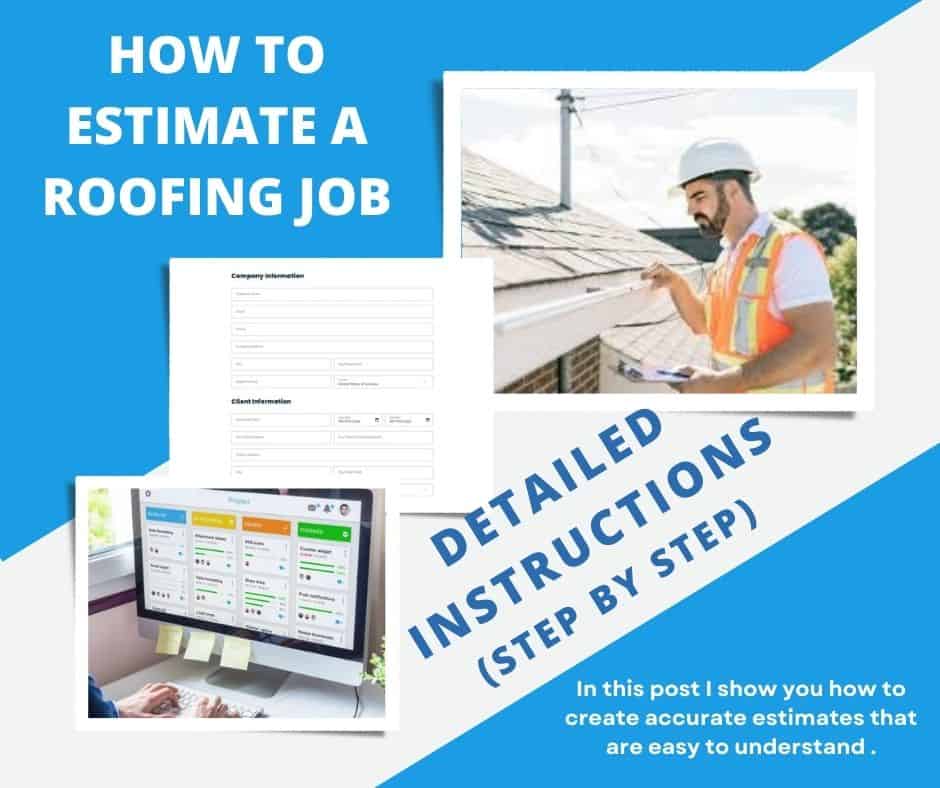
When you are asked to estimate a roofing job, it’s important to remember a few key things. You need to take into account a variety of factors in order to give an accurate estimate.
In this blog post, we will walk you through all the steps involved in putting an estimate together. By following these instructions, you can be sure that your estimate is as accurate as possible!
How to Estimate a Roofing Job
If you’re a roofer, then you know that one of the most important aspects of your job is pricing. That’s because, in order to price a job correctly, you need to take into account a number of different factors.
The first step is to inspect the roof and get an accurate measure of its size (how many squares). Then you need to speak to the customer to ascertain exactly what they want.
Once you have all of this information, you can determine the roof pitch and calculate the base cost for the materials. 215387
From there, you can add labor hours (hourly wage), material waste, and business overheads to the final price.
Don’t Get Caught Underquoting
Roofing is a big business, and it’s only getting bigger. According to Roofing Contractor, the roofing industry is expected to grow by more than $5 billion over the next four years.
With so much money on the line, you would think that roofing professionals would be experts at pricing and estimating jobs.
Unfortunately, that’s not the case. According to the same article, more than nine out of 10 roofing professionals will fail to achieve their revenue goals because they price and estimate jobs incorrectly.
There are a number of reasons why roofing professionals might struggle to price and estimate jobs correctly. For one thing, roofing is a complex job with many variables.
There’s also a lot of room for error when you’re measuring a roof. And, of course, there’s always the potential for material waste and other unforeseen costs.
Fortunately, there are a few things you can do to make sure you price and estimate roofing jobs correctly.
Don’t worry, we’ll walk you through everything you need to consider when estimating a roofing job. By following these instructions, you can be sure that your job estimate is as accurate as possible!
Disclaimer: This article contains affiliate links that I receive a small commission for at no cost to you. However, these are merely the tools I fully recommend when it comes to Estimating Software. You can read my full affiliate disclosure in my privacy policy in the footer.

Step 1: Inspecting the Roof
Estimating for a new roof can be tricky- there are so many variables to consider!
But one of the most important things you can do is inspect the roof beforehand. This way, you can price for any potential issues that might come up during installation.
Here are some things to look out for:
- The roof’s size: You’ll need to know the roof area of the roof in order to estimate material costs.
- The roof’s pitch: The angle of the roof will affect how easy or difficult it is to install. It will also affect the material costs and installation.
- The roof’s condition: If the roof is in poor condition, you’ll need to factor in the cost of repairs.
- The type of roofing: There are many different types of roofing available, and each one has a different price.
- How easy is it to access the roof? If it’s hard to get to, it will take longer
- Are there any holes or cracks? These will need to be filled in before installation.
- Is the roof heavily damaged or deteriorated? This will require more work and materials.
- Are there any other special requirements such as solar panels or skylights?
Clients often think they know what they want, but as any experienced roofer will tell you, they usually don’t.
That’s why it’s important to carefully inspect the roof to identify any damaged areas, the number and condition of valleys, unusual roof features and the state of the flashing.
Make sure to take photos and detailed notes of these areas so you can attach them to your client’s profile for future reference.
This will help you price the job more accurately and avoid any surprises down the road, and with careful inspection and good documentation, you can ensure that your estimate is as accurate as possible.
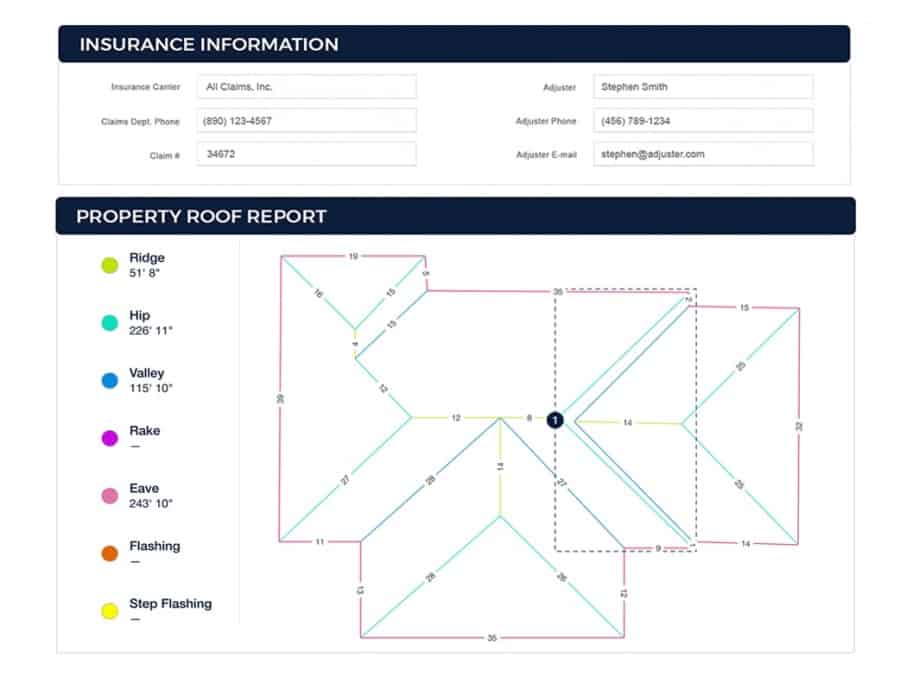
Step 2: Measure The Roof
Getting onsite and measuring the roof is extremely important because it really helps you price the job and determine the number of squares to install.
To calculate the number of squares, follow these three steps:
1. Measure the length and width of the roof.
2. Multiply the length by the width to get the square footage.
3. Divide the square footage by 100 to determine the number of squares.
For example, if the roof is 10 feet wide and 20 feet long, the square footage would be 200. This means that you would need two squares of roofing material.
It’s important to be accurate when measuring the roof so that you can price the job correctly and avoid running out of material.
By following these simple steps, you can be sure that your estimate is as accurate as possible.
Step 3: Look Up Building Codes
One of the most important aspects of estimating is to make sure you check the building codes in the area. This is because certain areas have restrictions on what materials and colors can be used.
For example, many housing estates require that all houses use uniform materials and colors.
If you fail to check the relevant codes, you may end up using material that is not allowed in the area, which could lead to hefty fines.
Therefore, always make sure to check the building codes before submit final pricing for the job.

Step 4: Speak To Your Client
It’s always important to speak with your client directly and ask as many questions as you need to in order to get a clear understanding of the project.
Things you want to ask is, What kind of home is it? What are their expectations? What is their budget?
By asking these types of questions, you’ll be able to build a strong relationship with your client and give them an accurate estimate.
If you don’t take the time to price the job correctly, you could end up losing money on the project.
So, make sure you ask all the right questions and get all the information you need before giving your estimate.
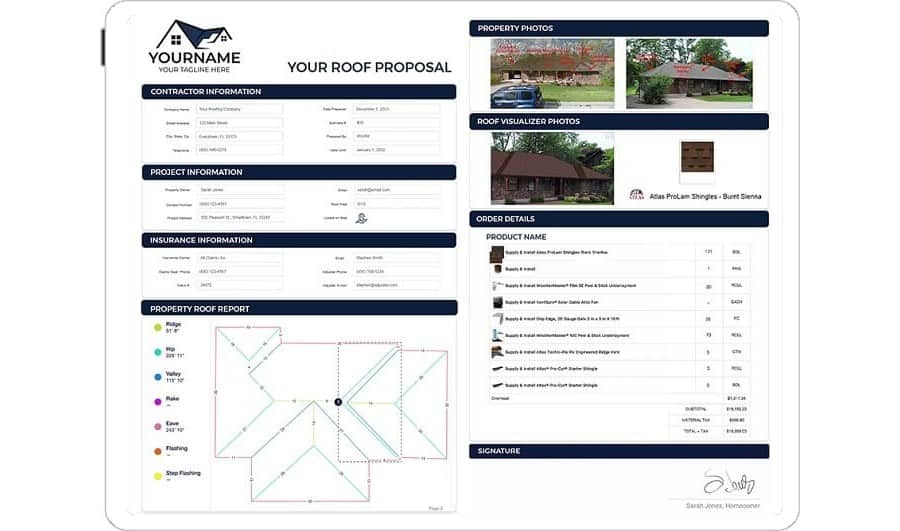
Step 5: Prepare A Scope Of Work
It’s not always that easy pricing up a roofing job. On the one hand, you want to make sure you’re making enough money to cover your costs and make a profit.
On the other hand, you don’t want to price yourself out of the job.
To strike the right balance, it’s important to prepare an accurate work scope. This means taking into account all of the materials, labor hours, and overhead costs that will be involved in the job.
It also means being clear about what work is and isn’t included in the scope of work. By taking these steps, you’ll be able to price more accurately and compete more effectively for work.
Step 6: Determine The Roof Pitch
One of the first things you need to do is determine the roof pitch. The pitch is simply the measurement of how steep the roof is, and it’s a crucial factor in determining the price of a roofing job.
There are a few different ways to measure pitch, but the most common is by using a twelve-inch level. To do this, simply place the level on the roof and measure the distance from the level to the highest point on the roof.
This measurement is called the rise, and it can be used to calculate the pitch. For example, if the rise is four inches, then the pitch would be 4/12, or 1/3. The pitch of a roof can also be expressed as a ratio, such as “one in twelve” or “two in twelve.”
Pitch is important because it affects the amount of material needed for the job, as well as the amount of time it will take to complete the roofing project. Flat roofs are usually cheaper, a steeper roof will require more material and more time, and therefore will be more expensive.
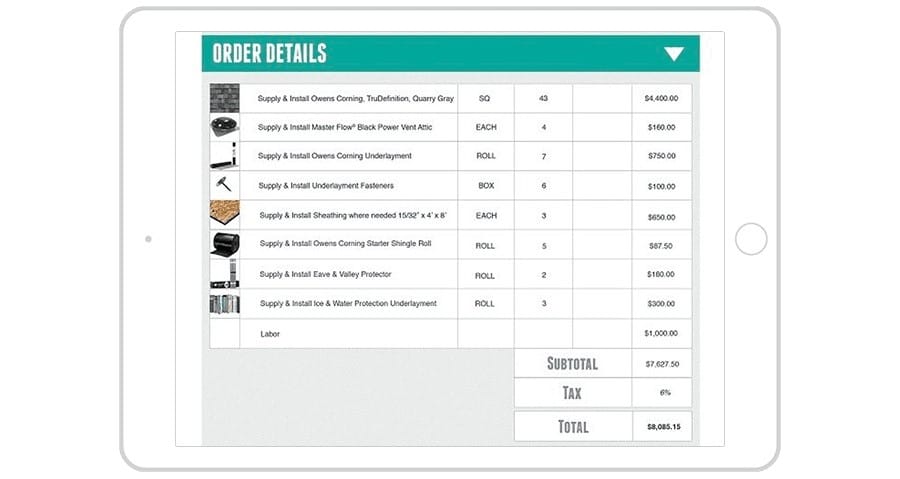
Step 7: Estimate Material Cost
This is one of the most important aspects of estimating, you can’t get this one wrong. It’s super important to get an accurate list of all the materials you’ll need to complete the job.
For a shingle roof you’ll need to include costs for all the following materials:
- Roofing Shingles
- Ridge Cap Shingles / Hip / Valley Shingles
- Drip Edge – eaves and rakes
- Ice & Water Shield
- Underlayment
- Roofing Nails
- Flashing
- Vent Boots
This helps to accurately calculate the cost which is important when creating an roofing estimate. The price of roofing materials can vary widely, so it’s important to compare prices and get several quotes from roofing suppliers before making a decision.
Other factors that will affect the price of a roofing job include the type of roofing material you choose, the size of the roof, and the complexity of the job.
Plan For Waste Factor
An estimate needst to takes into account the many factors that can contribute to the cost of a roofing job – including the price of materials, labor, and any other associated costs.
But one factor that is often overlooked is the potential for waste. Depending on the type of roof, the complexity of the job, and the quality of the materials, there can be a significant amount of waste.
As a result, it’s important to factor this potential waste into the price when quoting for the job. Otherwise, you run the risk of being caught off guard by unexpected costs – and that’s never a good position to be in.
Step 8: Estimate Labor Costs
Estimating for the labor cost can be tricky, as there are many variables to consider, such as the size and pitch of the roof, the type of roofing materials, and the region where the job will be completed.
However, there are a few general guidelines that can help to make the estimating process a little easier.
1. First, identify the scope of work. What type of roofing project are you undertaking? This will help you determine the number of workers you’ll need, as well as the duration of the job.
2. Next, calculate the hourly rate for each worker. This should take into account their experience level, as well as any special skills or training they may have.
3. Once you have your workers’ hourly rates, multiply them by the number of hours you estimate the job will take. This will give you your total labor cost.
Other variables to consider include:
- The experience level of the roofing crew. A team of experienced roofers will be able to complete the job more quickly and with fewer errors than a team of inexperienced workers.
- The type of roofing materials being used. Materials like asphalt shingles are relatively easy to work with and can be installed quickly.
- Concrete tiles, on the other hand, are much heavier and more difficult to work with, which will increase the labor costs.
- Metal roofs are also quite difficult to install, so it’s important to factor in a higher labor cost for these jobs.
- Finally, it’s important to consider the region where the job will be completed. Roofing jobs in warm, sunny regions will be easier and faster to complete than roofing jobs in cold, snowy regions.
By taking all of these factors into account, you can get a more accurate estimate of the labor costs for your roofing job.
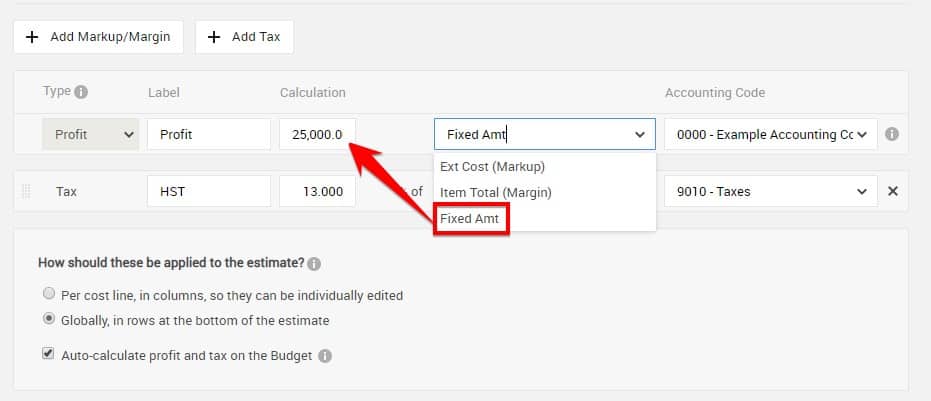
Step 9: Don’t Forget To Add Overhead Cost / Markup
When you are estimating a roofing job, you will need to calculate your markup. This is the amount you add to the cost of your services to make a profit.
You can express markup as a percentage. To calculate it, divide your desired profit by the cost of the job, and then multiply that number by 100.
The markup percentage you choose to add to your break-even cost price will depend on your desired profit margin. That is, how much profit you want to earn for this job.
The formula to determine your margin is Profit/Sales*100. A general guideline for pricing roofing jobs is to aim for a margin above the industry average of six percent.
However, you may need to adjust your markup depending on the specific job and your company’s overhead costs.
For example, if you have a lot of overhead costs, you will need to charge a higher markup percentage to make a profit. Alternatively, if the job is very simple or you have low overhead costs, you can charge a lower markup percentage.
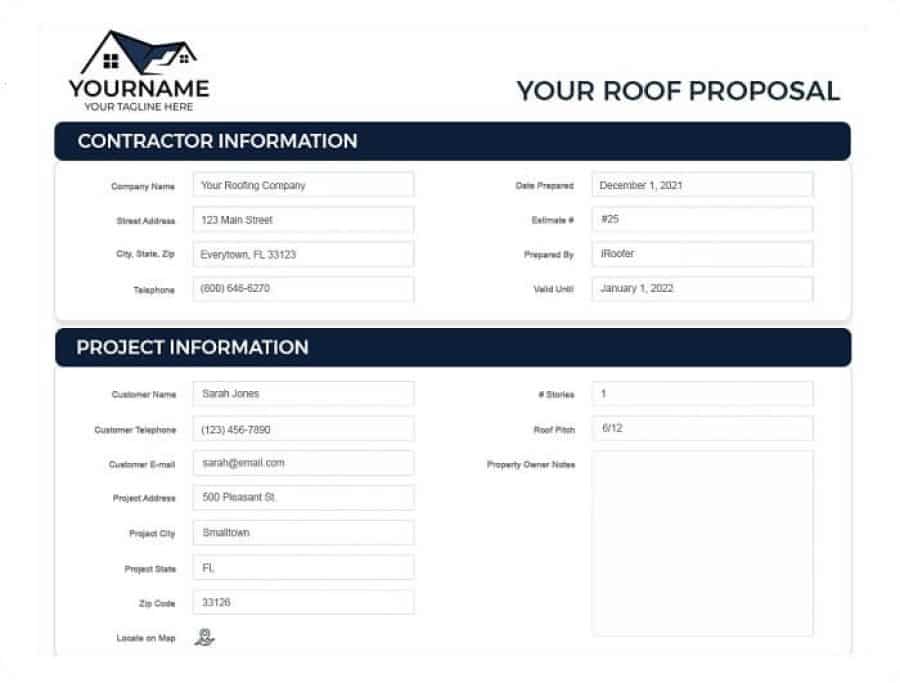
Step 10: Price Roofing Jobs Professionally
Now that you have an estimate for your roofing job, it’s time to get down to the nitty gritty and create a quotation. This document should be easy to read and understand, so take some time to format it in a way that is professional and presentable.
Start by gathering all the pertinent information about the job, including the products and services you will be providing. Once you have this information, you can begin creating your quotation.
Be sure to include reference to your proof of license, insurances, and termination clauses, as well as estimated start and finish dates. And, most importantly, make sure your quotation is easy to read and understand.
A well-presented quote will give your customer confidence in your roofing business and increase the chances that they will choose you for the job.
See below for a more complete list of inclusions:
- The estimate should include the cost of materials, labor, and any other associated costs.
- Company name and logo
- Your name and title
- The customer’s name and address
- The date of expiry, plus the estimated start and finish dates of the project
- A description of the work to be performed
- It should itemize each roofing service being provided
- Include any applicable warranties or guarantees
- Note any special conditions, such as working around obstacles or difficult access
- Make sure your estimate is easy to understand and free of errors
- That the estimate is easy to understand and free of errors. Providing a clear and accurate estimate is crucial to landing the roofing job
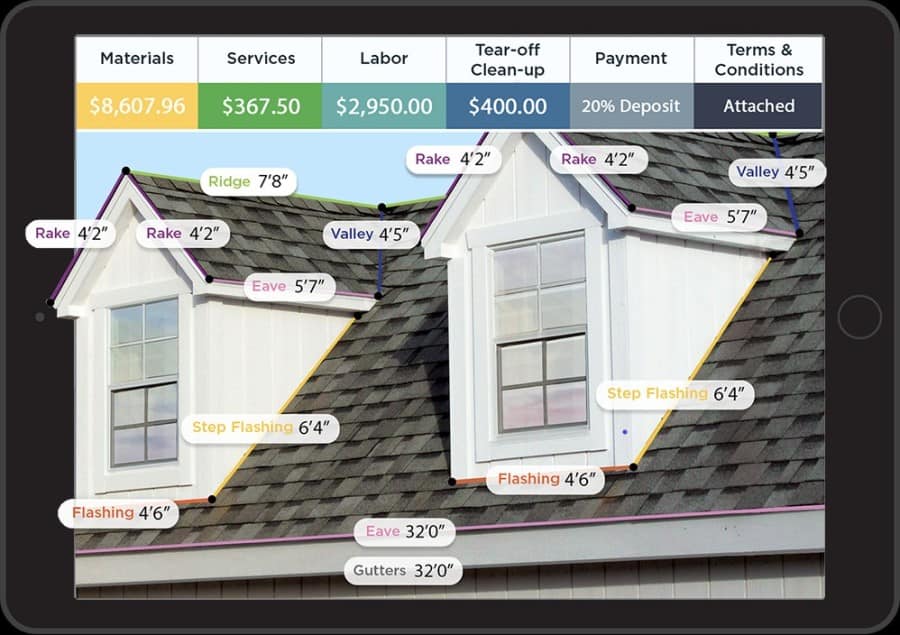
Online Roof Estimating Tools
If you find yourself spending hours upon hours trying to pricing multiple jobs, you might want to consider an online roofing estimating software.
These programs can help you streamline the process and build more professional looking bids quickly, reducing human error.
With the ability to store and update information online, you can easily price and bid roofing jobs, estimate the materials needed, and even schedule the installation.
Plus, they often come with built-in databases of materials and prices, so you can be sure you’re getting accurate pricing information. And if there are any changes or updates, you can make them quickly and easily online.
Best of all, these programs are typically very affordable and easy to use. So if you’re looking for a way to save time and money on your next roofing project, consider using an online roofing estimator.
What Is A Roofing Bid?
A roofing estimate or bid is a document that shows your potential customer the cost and pricing breakdown of their roofing project.
It includes the services your company will provide, how much each service will cost, additional service notes, and important terms and conditions.
Your estimate must be approved by the client, and cannot change once agreed upon between you and the customer.
Providing a detailed estimate shows your professionalism and commitment to your craft, and can help you land the roofing job.
Some Quick Things You Can Do Today To Win More Roofing Jobs
As a roofing contractor, it’s important to know how to estimate a job so you can win more work. Here are some tips on how to do just that.
Include photos of the roof and problem areas in your estimate, with a note on how you will address them. This will help you to stand out from the crowd.
Be sure to note any materials warranties in your quote. This will provide the customer with piece of mind that their money is safe.
Include testimonials from previous customers in your estimate to provide social proof that you are the correct company for the task.
Be thorough in your estimate. Include all potential costs, such as for repairs or replacement of damaged shingles.
Finally, be honest about the condition of the roof and the expected lifespan of the roofing materials. By being upfront about potential problems, you’ll build trust with your prospective clients and show that you’re a roofing contractor they can rely on.

